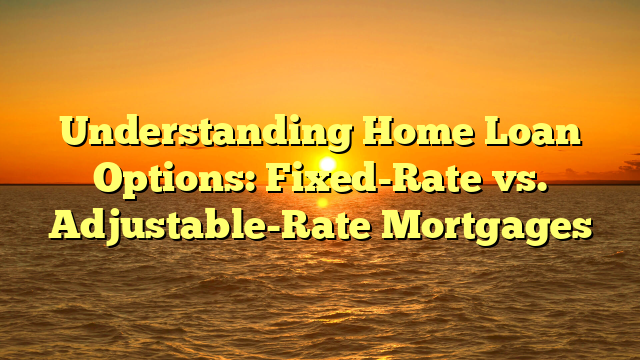When considering a home purchase, one of the most significant decisions you’ll face is choosing between a fixed-rate mortgage (FRM) and an adjustable-rate mortgage (ARM). Each option has its advantages and considerations, impacting your monthly payments, budgeting, and financial stability. This article explores the differences between fixed-rate and adjustable-rate mortgages to help you make an informed decision.
Fixed-Rate Mortgages (FRMs)
1. Predictable Payments: With a fixed-rate mortgage, your interest rate remains constant throughout the loan term, providing predictability and stability in your monthly payments. This makes budgeting easier and offers protection against interest rate fluctuations.
2. Long-Term Planning: FRMs are ideal for homeowners who prioritize long-term financial planning and prefer the security of knowing their mortgage payments will not change over time. They offer peace of mind and stability, particularly in times of economic uncertainty.
3. Higher Initial Rates: Fixed-rate mortgages typically have higher initial interest rates compared to adjustable-rate mortgages. However, this higher rate provides certainty and protection against potential rate increases in the future.
4. Higher Total Interest Paid: While FRMs offer stability, they may result in higher total interest payments over the life of the loan, especially if interest rates decline in the future and you are unable to refinance to a lower rate.
Adjustable-Rate Mortgages (ARMs)
1. Initial Lower Rates: Adjustable-rate mortgages often start with lower initial interest rates compared to fixed-rate mortgages, making them attractive to borrowers seeking lower initial monthly payments or planning to move or refinance before the initial rate period ends.
2. Potential for Rate Adjustments: Unlike fixed-rate mortgages, ARMs are subject to periodic adjustments based on changes in market interest rates. This can lead to fluctuations in monthly payments, making budgeting more challenging and potentially increasing financial uncertainty.
3. Rate Caps and Limits: Most ARMs include rate caps that limit how much your interest rate can increase or decrease during each adjustment period and over the life of the loan. Understanding these caps is essential for assessing the potential risk and affordability of an ARM.
4. Consideration of Future Scenarios: When considering an ARM, it’s essential to evaluate potential future scenarios, including how future interest rate changes may impact your monthly payments and overall financial stability. Assessing your ability to absorb potential payment increases is crucial for determining whether an ARM is suitable for your needs.
Choosing the Right Option
When deciding between a fixed-rate and adjustable-rate mortgage, consider your financial goals, risk tolerance, and long-term plans. If you value stability and predictability in your monthly payments and plan to stay in your home for an extended period, a fixed-rate mortgage may be the preferred option. On the other hand, if you anticipate a shorter-term stay, are comfortable with potential payment fluctuations, or are seeking lower initial payments, an adjustable-rate mortgage may be worth considering.
Conclusion
Both fixed-rate and adjustable-rate mortgages offer distinct advantages and considerations, depending on your financial circumstances and preferences. Understanding the differences between these options and evaluating your long-term financial goals are essential steps in choosing the right home loan for your needs. By carefully weighing the pros and cons of each option and seeking guidance from mortgage professionals, you can make an informed decision that aligns with your homeownership goals and financial objectives.
